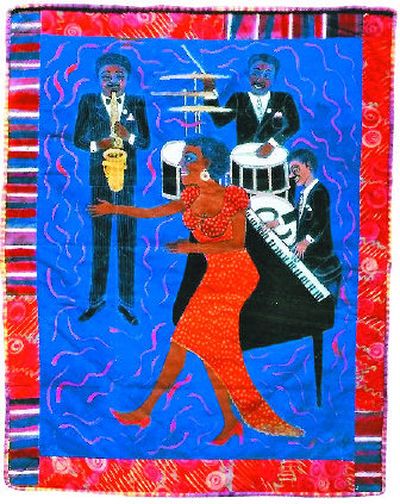Queen of quilts

Artist Faith Ringgold soars in a magical place.
Like the 8-year-old heroine in her most famous quilt, “Tar Beach,” she dreams big.
Ringgold – painter, author, speaker and educator – is due in Spokane today for public activities around her current exhibition at Gonzaga University’s Jundt Art Museum.
One of the country’s pre-eminent African American artists, Ringgold is best known for her large, painted quilts that combine storytelling and quilt making with genre painting.
“I began writing on my quilts in the early ‘80s because I could not get published,” she says.
“I figured if I wrote a story directly onto my quilt, then when someone took a picture of my work they would also have a picture of the story, so it would be published.”
In “Tar Beach,” painted in 1988, a young girl named Cassie dreams of flying above New York City, claiming all she sees.
The painting – part autobiographical, part fiction – depicts adults laughing and playing cards while two children gaze up at the starry sky from a blanket spread out on their “tar beach.”
“When I was a kid,” recalls Ringgold, “on warm summer nights we would go up to the tar-papered roof of our Harlem apartment building to cool off.”
An editor from Random House saw the painting with its handwritten text and thought it would make a great illustrated children’s book.
“It happened quite unexpectedly,” says Ringgold. “On my way to doing something else I wrote my first children’s book.”
After the award-winning “Tar Beach” book was published in 1991, Ringgold went on to write and illustrate 10 more children’s books and illustrate three others. In 1995 she published her memoirs, “We Flew Over the Bridge.”
Born in 1930, Ringgold says she had “a wonderful childhood growing up in Harlem with many wonderful role models as neighbors,” including Supreme Court Justice Thurgood Marshall, singer Dinah Washington, educator Mary McLeod Bethune, artist Aaron Douglass and bandleader Duke Ellington.
Early in her life she learned sewing from her fashion designer mother and quilt making from her great-great-grandmother. By high school she knew she wanted to be an artist and went on to receive her undergraduate and master’s degrees from The City College of New York.
Ringgold’s subsequent struggles to establish herself as a black artist and her need to define the meaning of “women’s art” became major themes in her projects.
“My ideas come from reflecting on my life and the lives of people I have known and have been in some way inspired by,” Ringgold writes on her Web site.
“I am both enriched and limited by what I know and have experienced,” she says. “In other words my books and my art are based on my life’s experience – a black woman in America.”
Karen Kaiser, assistant curator for the Jundt Art Museum, says: “Ringgold has been a social activist her entire life. She helped spearhead the movement of getting recognition and equity for African American and women artists in museums and gallery spaces.”
In the 1970s Ringgold was one of the first female artists to start making serious art in traditional women’s mediums such as textiles, weaving, quilting and embroidery. Over the years she created hundreds of artworks including soft sculptures, dolls and masks.
But she always returns to the quilt art format.
“I like the way art looks when it is quilted,” says Ringgold. “I don’t think I would be happy anymore with that real flat surface of a stretched canvas. I like some stitching in my paintings.”
She adds: “It also feels right that the stories are there. The whole aesthetic of it is very pleasing to me.”
No matter what the subject of Ringgold’s narrative work, it is executed in a “poster style,” says Kaiser.
“It is very graphically strong with heavy outlines, bright colors and flat patterns,” she says.
Because of the flattened perspective, some refer to Ringgold’s style as folk or naïve art.
“It has some of that look about it,” says Kaiser, “but mostly that is because of her treatment of space. It is a very shallow space, where figures are kind of stacked one on another; folk artists and naïve artists often do that.”
During Ringgold’s exemplary career as an artist, author and educator she has received more than 75 awards including 18 honorary Doctor of Fine Arts degrees.
On Wednesday the Washington State University Women’s Studies Department honored her as the Jo Hockenhull Distinguished Visiting Lecturer for 2006/2007.
Ringgold’s artwork is included in public and private collections around the world including the Art Institute of Chicago, Baltimore Museum of Art, Boston Museum of Fine Art, Metropolitan Museum of Art in New York City, National Museum of American Art in Washington, D.C., and Victoria and Albert Museum in London.